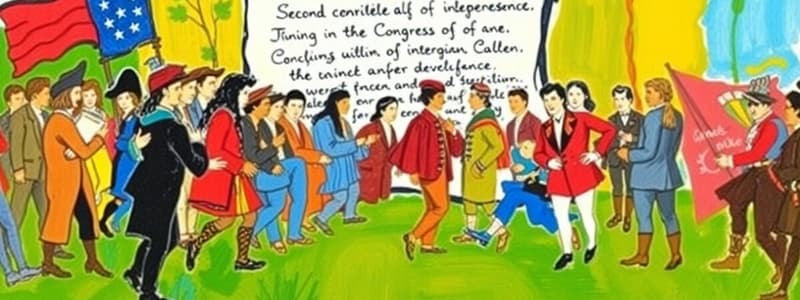Podcast
Questions and Answers
George Washington was appointed commander of the Continental Army by the First Continental Congress.
George Washington was appointed commander of the Continental Army by the First Continental Congress.
False (B)
Thomas Jefferson was chosen to draft the Declaration of Independence.
Thomas Jefferson was chosen to draft the Declaration of Independence.
True (A)
The Declaration of Independence was approved on July 4, 1776.
The Declaration of Independence was approved on July 4, 1776.
True (A)
The Articles of Confederation established a centralized government for the newly independent states.
The Articles of Confederation established a centralized government for the newly independent states.
The Articles of Confederation went into effect in 1781, after the surrender of British troops.
The Articles of Confederation went into effect in 1781, after the surrender of British troops.
King George III recognized the United States as an independent nation in 1783.
King George III recognized the United States as an independent nation in 1783.
The government under the Articles of Confederation proved to be very efficient and effective in decision-making.
The government under the Articles of Confederation proved to be very efficient and effective in decision-making.
The constitutional convention was held in 1787 to reinforce the Articles of Confederation.
The constitutional convention was held in 1787 to reinforce the Articles of Confederation.
The Declaration of Independence emphasized the natural rights of individuals.
The Declaration of Independence emphasized the natural rights of individuals.
One of the passages in Jefferson's draft of the Declaration condemned slavery.
One of the passages in Jefferson's draft of the Declaration condemned slavery.
Flashcards
Second Continental Congress
Second Continental Congress
The governing body of the thirteen colonies during the American Revolution, formed in May 1775. It appointed George Washington as commander of the Continental Army and played a crucial role in drafting the Declaration of Independence.
Declaration of Independence
Declaration of Independence
A document that declared the thirteen American colonies independent from Great Britain, adopted by the Second Continental Congress on July 4, 1776. It outlined the natural rights of individuals and argued for separation based on King George's violation of these rights.
Natural Rights
Natural Rights
Rights inherent to all individuals by virtue of their humanity, often considered universal and inalienable. In the Declaration of Independence, these are described as 'Life, Liberty, and the pursuit of Happiness.'
Articles of Confederation
Articles of Confederation
Signup and view all the flashcards
Confederation
Confederation
Signup and view all the flashcards
Recognition of Independence
Recognition of Independence
Signup and view all the flashcards
Inefficient Government
Inefficient Government
Signup and view all the flashcards
Constitutional Convention
Constitutional Convention
Signup and view all the flashcards
Revolutionary Process
Revolutionary Process
Signup and view all the flashcards
Effective Government System
Effective Government System
Signup and view all the flashcards
Study Notes
Second Continental Congress
- Patriots called for a Second Continental Congress in May
- George Washington became commander of the Continental Army
- Congress sent a peace proposal to King George
Declaration of Independence
- Congress formed committees for important tasks
- Five delegates wrote a Declaration of Independence, with Thomas Jefferson as one of them
- Jefferson combined various ideas about life, liberty and the pursuit of happiness to persuade colonists
- Governments should protect individual rights, not violate them, as King George had done
- Congress debated Jefferson's points; some ideas, such as those against slavery, were removed
- The Declaration of Independence was approved on July 4, 1776
Articles of Confederation
- Congress approved the Articles of Confederation in 1781
- It established a union of separate states (a confederation)
- Power to make most decisions was given to the individual states, not a central government
French Involvement
- In 1778, France joined the fight on America's side, which was a turning point
- British troops surrendered in 1781, concluding the war
Nation's Independence Recognized
- King George recognized the nation's independence in 1783
- The newly formed government was ineffective due to disagreements among states
Constitutional Convention
- The revolution ended in 1783
- The work of shaping government continued with the Constitutional Convention in 1787
Studying That Suits You
Use AI to generate personalized quizzes and flashcards to suit your learning preferences.




